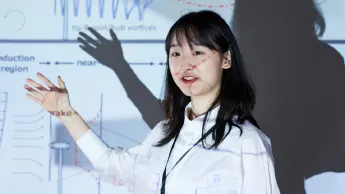Pecha Kucha – How does the Japanese format work?
- 2021-10-05
- Eva Lindner
- Comment

Pecha Kucha is a presentation technique from Japan that follows strict rules: an oral presentation is visually supported by 20 images that are displayed every 20 seconds. Image and text are thus divided into short and easily understandable units. The lecture is limited to six minutes and 40 seconds. Two architects presented the format for the first time in Tokyo in 2003.
At a Pecha Kucha event, one speaker after the other gives their oral presentation, each of which is illustrated with 20 slides. The topics include areas such as travel, design, art, nutrition, culture or architecture. A few examples of content presented in the Pecha Kucha format are poetry analyses, travel reports or explanations of political processes.
WHAT MAKES PECHA KUCHA SO SPECIAL?
The strict time limit and visualisation rules make for fast-paced, to-the-point presentations. Long lectures with often tiring PowerPoint presentations that contain too much text are avoided. The slides usually show images, designs or graphics that do not distract the listeners too much from the speech. The spoken word and the images complement each other without being redundant. It is a format that is suitable for giving comprehensible insights into processes, for concise accounts of short analyses, as well as for addressing a particular question briefly and intensely.
WHICH REQUIREMENTS NEED TO BE MET?
It should be possible to project the images onto a wall/whiteboard and to turn down the lights in the room. Outdoor events at night, much like open air cinema events, are also an option. The technical equipment available should include a headset or handheld microphone for the presenter, as well as a beamer and a laptop for playing the visual presentation (e.g. using PowerPoint).
WHICH TARGET GROUPS ARE SUITABLE FOR THE FORMAT?
Pecha Kucha is suitable for short presentations by interested individuals, students or business partners. The technique can be used when a very short time period is allocated for the presentation, when there is a large number of speakers, or if the key goal is to introduce the audience to the essential facts of a topic, using a quick and enjoyable format.
About 5-10 x 6:40 minutes per lecture // in total approx. 1-2 hours
What makes a great Pecha Kucha Presentation
Brian Scott Peterson has seen thousands of Pecha Kucha presentations and examples and given many himself. He explains what makes a really good PechaKucha presentation
Special Tip: Pecha Kucha in practice
More than 10,000 presentations have been held in over 140 countries around the world to date. A list of all cities around the world, where Pecha Kucha events are held and recordings of many presentations are available at .
The website also contains examples of Pecha Kucha presentations for a wide variety of applications. Click here to go directly to Pecha Kucha presentations in science communication: .
Continue reading on the Alumniportal Deutschland
In a park, a square or the street, Soapbox Science – involving a couple of enthusiastic female researchers, random passers-by and a soapbox – brings science to the people. From our series on the most effective formats of science communication.
TED talks are inspirational talks that are not easily forgotten. At a TEDx event, researchers inspire with their ideas for a better world. From our series on the most effective formats of science communication.
